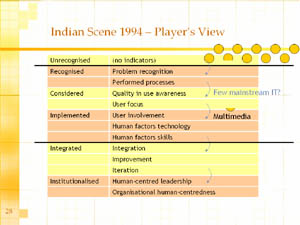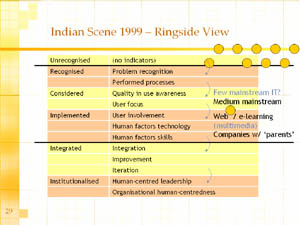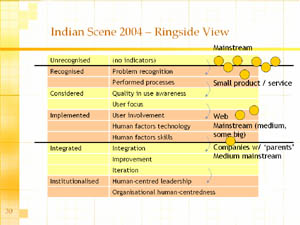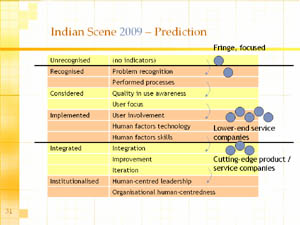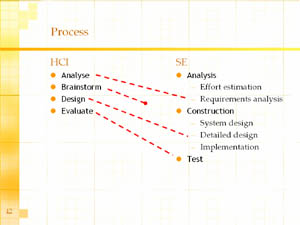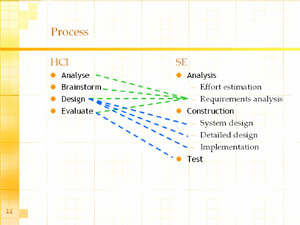WHITE PAPER
Institutionalizing HCI - the Challenges in India
Anirudha Joshi, IDC, IIT Bombay
(Based on a talk in the 39th Annual National Convention of the Computer Society of India, Taj Lands End, Mumbai, December 3, 2004)
Abstract
The 'Usability Maturity Model' (UMM) is a measure of the progress of usability and human-computer interaction design (HCI) in a company. The key challenges in improving maturity are lack of awareness, lack of skills, lack of techniques suiting the Indian business model and inability to convert HCI into a profitable business proposition. On the other hand, software engineering has been a major strength of the Indian IT industry. Though software engineering and HCI evolved as almost independent disciplines, they have a lot of common ground between them. Opportunities for the Indian industry lie in developing this common ground and integrating it in the software development process.
- Human-Computer Interaction Design
- Usability Maturity in India
- Challenges in the Indian Context
- Research Opportunities: HCI and SE
- Conclusion
- References
Human-Computer Interaction Design
While there are many views on the subject, the following will serve us as a working definition of what Human-Computer Interaction (HCI) design: “The task of designing the activities of a human being with a product in which a computer substantially affects those activities.”
HCI is informed by many fields - Computer Science, Cognitive Psychology, Human Factors, Information Science and Design, to name just a few. While each of these fields have had a fairly long history in the evolution of modern society, HCI itself must be still considered to be a nascent field, with but a short history. The issues that matter in the context of design of interactive devices and systems are still new to us, and only time will tell if we have already identified them all. The claim of those who profess to 'already know it all' is similar to the bravado of the six blind men who knew the elephant.
In this context it becomes important to consider the maturity of organizations that are actually involved in design and development of interactive products and systems.
Usability Maturity in India
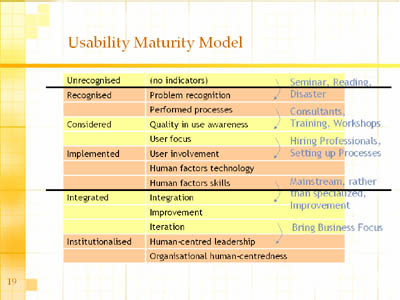
The 'Usability Maturity Model' (UMM) [1] can provide a scale to measure the progress of HCI capabilities of a company.
- A company is considered in the Unrecognized level if people in the company believe that there are no problems related to usability of its products, and it does not need to make any investment in developing HCI skills.
- The progression to the next level Recognized is rather unsystematic. Occasionally, an employee from the company reads a book or attends a seminar. More often, a disaster strikes - a client returns a job or a product bombs in the market. Typically, confusion reigns at this level and nobody is sure what the problem was and how to solve it. This level is marked with sincere, but haphazard attempts to resolve the usability issues of the problem cases.
- A company moves to the Considered level when it starts making some financial investments. This happens either in terms of hiring HCI consultants on specific projects or by sending employees to HCI related training.
- Companies move to the Implemented level when they realize that they need to do this on an on-going basis and set up a specialized group to handle 'user interface design'. This group typically has the necessary HCI skills and brings in systematic involvement of users. At this level, the group is still handling special projects which have critical UI issues and, typically, where client is willing to pay for this involvement.
- A company is considered Integrated when HCI design activity becomes mainstream and routine for all projects. At this level the company also sets up feedback loops and knowledge sharing mechanisms to ensure continuous process improvement and penetration. At this level the company consistently produces usable products and their desirability is on the rise.
- A company would be considered Institutionalized when it starts considering itself as a human-centered solutions company rather than a technology company. Such a drive needs to happen from the top leadership. A company at this level not only produces consistently usable products, it also produces products which are desirable to its customers.
In this path of companies' maturity, two levels are hardest to cross:
- Unrecognized to Recognized: This change represents a major cultural change for a technology company. In the past, technology has been a major strength of the company and was always sufficient to deliver what the client wanted. However, the very success of technology and its wide spread has changed the world. It is important to recognize that success of the past is the very reason why the future needs to be different.
- Implemented to Integrated: Once a company recognizes that they have a problem, there is usually enough maturity in the processes to make financial investments to move to Considered (training, consultants etc.) and then to Implemented (specialized HCI group). This is where they face the next major barrier. Moving from Implemented to Integrated requires a significant change of scale - it is not a matter of setting up a group of 8-10 HCI specialists any more. HCI people need to be a part of each project within the company. That can be quite a task for a company of 5,000+ people and 500+ projects annually.
The HCI Maturity of Indian IT Companies
|
||
|
||
|
||
|
Challenges in the Indian Context
Following is a discussion of the key challenges in the path of usability maturity of the Indian IT industry.
Lack of Awareness
Education, or the lack of it, is the main reason why there is less awareness about this field. Even today, very few engineering students have even the option of getting inputs in HCI. There is a great need to start electives, if not compulsory courses, in HCI that every student passing out of IT and CS departments of engineering colleges, NITs and IITs takes.
The 'client-centered' business model of IT service companies, I believe is the other reason why the awreness of HCI is low. Like many quality aspects, most HCI deliverables are 'taken for granted' by customers, and will not be explicitly asked for up-front, unless there is experience of prior pain. As a result, the first client disaster is the usual 'wake-up call'.
Lack of Skills
In its brief history, the field of HCI has widely adapted several techniques from its parent disciplines. There are techniques for understanding users and analyzing their requirements (contextual inquiry, focus groups, work models, affinity diagrams etc.), techniques for goal-driven creative design (brainstorming, personas, scenarios, storyboards etc.) and techniques for iterative evaluation (heuristic evaluation, user tests, expert reviews, card sorts etc.).
Few educational institutes in India teach these specialized skills in the context of design of interactive products. Estimates of how many specialized HCI professionals India needs vary from a modest 40,000 to a high 400,000 [2]. But even the smaller figure is much higher than the currently estimated industry strength of about 700 professionals.
Current Techniques Don't Suit the Indian Business Model
Current techniques extensively rely on close and continuous contact of the HCI design team with the users. The business model of both product and service companies in India relies on distributed development, with the bulk of the work being done 'off-shore' from the target users. Moreover, the people involved in the 'on-site' components of projects typically are involved in marketing or project management activities and are often disinclined to do HCI related tasks.
Converting HCI into a Business Proposition
Finally, HCI activities in India will become sustainable only in those companies that are able to convert them into profitable business opportunities. There is no disputing the fact that there is potential in HCI for Indian companies. HCI skills could possibly be the key that makes the Indian IT industry earn 10-40 billion USD by year 2010, instead of the projected 8 billion USD [3]. But potential does not automatically get realized into the bottom line unless there is a plan to do so at the top.
Research Opportunities: HCI and SE
Software engineering (SE) has been a major strength of the Indian IT industry. Though SE and HCI evolved as almost independent disciplines, they have a lot of common ground between them.
Process
|
||
|
Boundary Techniques and Objects
|
||||||||||||||||||||||||||||||||||||||||
Conclusion
Indian IT service companies have the opportunity to move up the value chain and product companies have the opportunity to dominate the market in the next five years, provided they acquire skills, modify and continuously improve techniques to suit their business model find ways to make HCI sustainable. Specifically, opportunities lie in developing common ground of SE and HCI processes and in creating boundary techniques and objects in both professions.
References
[1] Earthy J, Usability Maturity Model: Human Centeredness Scale, Lloyd’s Register (1998)
[2] Nielsen J, Offshore Usability, http://www.useit.com/alertbox/20020916.html last accessed on December 13, 2004
[3] The Economic Times, November 11, 2004, India set to capture IT biz worth $8 bn, http://www.nasscom.org/artdisplay.asp?Art_id=3657 last accessed on December 13, 2004
© 2004, IDC, IIT Bombay
